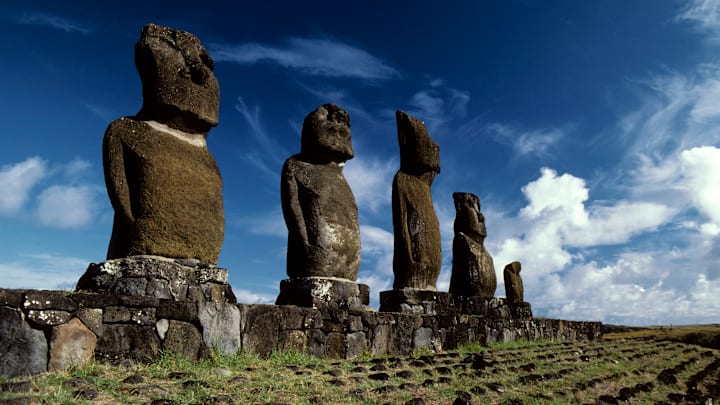When British explorer James Cook arrived at Rapa Nui — known to him as Easter Island — in 1774, he described small bands of malnourished people barely sustained by a barren, treeless strip of rock in the Pacific Ocean. “Nature has been exceedingly sparing of her favours to this spot,” he wrote. Yet, Cook had gone there to obtain supplies and to see marvels described by the two previous European expeditions to the island, the towering stone statues with oversized heads known as moai.
Rapa Nui presented an archeological mystery: The moai stand as high as 33 feet, weigh about 14 tons each, and were transported for display around the island. How did people on the remote volcanic outcrop, where day-to-day survival was a challenge, produce more than 900 of them? It seemed an almost impossible feat for a society separated from global technological development, 2300 kilometers from the nearest continent.
Some scholars have suggested a narrative of ecocide: Sometime before first contact with Europeans, a thriving Rapanui civilization rapidly consumed the island’s limited natural resources—explaining the lack of trees—perhaps to sustain the operation that created the moai. This, scholars say, led to a societal collapse that depopulated Rapa Nui and hastened its ruin before the European diseases and raids by Peruvian enslavers that decimated the island’s people in the 19th century.

New research from Binghamton University, Lamont-Doherty Earth Observatory at Columbia University, and other institutions casts doubts on the ecocide story. Researchers say that a survey of ancient rock gardens using satellite imagery indicates that Rapa Nui never had a population much larger than it did when a Dutch sailing crew became the first Europeans to reach the island in 1722.
Less Farming, Fewer People
To understand their conclusion, you might need a crash course in agriculture on volcanic islands. The first settlers arrived on Rapa Nui sometime before 800 CE. Farming conditions were harsh, and the population relied on a “soil” of plant waste and rock mulch to grow root vegetables.
Rapa Nui is about 40,500 acres, a little smaller than the land area of Washington, D.C. Determining how much of it was used for rock gardens is a way to estimate its peak population, and past scholars came up with ranges. A 2012 study by the University of Auckland used weaker satellite data and estimated between 2.5 and 12.7 percent of the island. The paper admitted that some areas could have been roads or other structures. But this earlier research left open the possibility that Rapa Nui’s peak population was as high as 17,000—which could support the theory that ecocide reduced the population to the 3000 people whom archeologists agree were on the island at the time of first contact.
The authors of the new paper, published in Science Advances, used satellite data that could detect moisture and soil components and claim that only 180 acres—or 0.4 percent of the island—was used for rock gardening. This would have supported only about 3000 people, perpetually.
Countering Collapse
The ecocide theory was first proposed in the early 1990s and popularized in historian Jared Diamond’s 2004 book Collapse: How Societies Choose to Fail or Succeed [PDF]. It seemed like a perfect cautionary tale for a world on the brink of climate change: A proud society capable of producing art and engineering wonders over-harvesting itself to a state of scarcity and tribal warfare. As Diamond wrote, “What did the Easter Islander who cut down the last palm tree say while he was doing it? Like modern loggers, did he shout, ‘Jobs, not trees!?’
Several archeologists and other researchers pushed back, citing radiocarbon dating and other methods of tracking human activity, to argue that the population of Rapa Nui grew or remained stable until first contact. Some of their evidence suggested the island had been deforested for as long as humans had lived on it. (One theory supposes that a breed of rat that came over with the first settlers destroyed the forests and native fauna.)
Some argue the ecocide theory paints the Rapanui people as ignorant and diminishes the impact of colonialism on their history. One prominent anthropologist wrote that it “turned the victims of cultural and physical extermination into the perpetrators of their own demise.” Now, with new scientific evidence, that narrative is changing.
Read More Stories About Archaeology:
